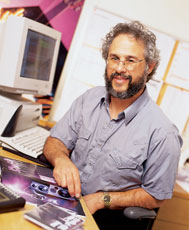By Steve Oppenheimer
(July 2000)
It’s easy to get lost in today’s technological marvels. My studio/home office is a cornucopia of hardware, the heart of which is my Power Mac, simultaneously one of my favorite tools and the bane of my existence.
I was hot to buy a new G4 with Mac OS 9, but the thrill is gone-at least, for the moment. Switching to the G4 and OS 9 has been far tougher than migrating to previous Mac operating systems and hardware because so many technologies changed at once. Perhaps the hardware problems would have occurred with previous models, but OS 9 has been a tragedy for me. After I finally worked out most of the early problems, Apple’s OS 9.0.4 updater screwed up my system. (I’ll bet I’m the only one who had that experience!) I have raged at OS 9’s incompatibility with OMS, suffered with orphaned and obsolete printer and scanner drivers, and a lot more. After this experience, Mac OS X is one Pandora’s box I am not ready to open. I have had all the cutting-edge computing I want for a while, thank you very much.
Many people had far smoother migrations to the new Macs, but I doubt my experience is unique. Apple has pushed users to adopt technologies that are not quite ready and in some cases are not even properly supported in the Mac OS. To make things worse, Apple has not yet addressed musicians’ specialized needs. For example, it could start by cleaning up the OMS/MIDI mess and ensuring that one can stream audio reliably to FireWire and USB drives from any audio program. Instead, Apple seems to be backing away from its recent initiatives for improving the Mac’s music-production capabilities. If Apple truly wants the Mac to remain a popular platform for multimedia-content providers, it must make good things happen for musicians and music-product developers.
Apple isn’t the only computer giant whose music support has been spotty. Microsoft has stumbled recently with Windows 2000 and Millennium. Ah, but that’s a story for another day.
How can we musicians respond? Obviously, we should look carefully before we leap into bleeding-edge technologies. But then, we electronic musicians like to experiment, and our software tools often require a lot of computing power. Aside from upgrading more cautiously, all we can do is set aside plenty of troubleshooting time.
We can also be less dependent on computers. I have temporarily returned to more traditional electronic music making, using a minimal system comprising an 88-key keyboard synth and headphones, to which I add a mic and a mixer when I want to sing. For tracking, I use an MDM, not the Mac. For effects and more synth and sampler voices, I turn to tried-and-true outboard hardware. The minimal version of this setup, in particular-a keyboard and cans-is reliable and fun to use. Best of all, it lets me focus on music instead of gear.
Make no mistake, I will still enjoy making music with the Mac when it works, because it allows me to do things I could not easily do otherwise. In truth, I am still fascinated with the darned thing. But while my computer continues to cause headaches, I am rediscovering the simple pleasure of just playing music.
